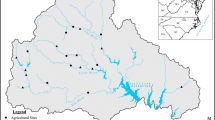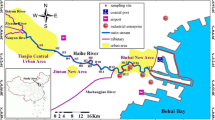Abstract
Railroad operations are a potential source for contamination of aquatic ecosystems. We examined concentrations of polyaromatic hydrocarbons (PAHs) and selected elements in sediments collected during 2009–2011 from streams, ditches, or ponds bisected or bordered by the former Elgin, Joliet, and Eastern rail line in the western Chicago, Illinois, metropolitan area. Summed PAH concentrations were greater in sediments collected downstream than in those collected upstream of the railroad and were negatively associated with distance within 500 m of the tracks. Phenanthrene and dibenzo (a,h)anthracene concentrations at some locations exceeded probable effect thresholds for risks to aquatic life. Although maximum levels of chromium (Cr) were below levels of concern, we did not determine the valence state of Cr; thus, risks to aquatic life could not be fully evaluated. Nickel and mercury concentrations exceeded lower effect levels, and vanadium concentrations exceeded chronic toxicity thresholds at some locations, although we did not detect an association between these elements and the presence of the railroad. Lead and arsenic concentrations were greater in proximity to the railroad; however, concentrations were below thresholds of concern for aquatic life. Our results suggest that the railroad and associated activities are contributing some environmental contaminants to waterways in close proximity to it, particularly in a downstream direction. Risks to aquatic life may be greater than implied by observed concentrations of individual contaminants, as synergistic adverse effects are likely to occur with exposure to complex mixtures.






Similar content being viewed by others
References
Burkhardt, M., Rossi, L., & Boller, M. (2008). Diffuse release of environmental hazards by railways. Desalination, 226, 106–113.
Chen, Z. Q., Wang, K. X., Ai, Y. W., Li, W., Gao, H. Y., & Fang, C. (2014). The effects of railway transportation on the enrichment of heavy metals in the artificial soil on railway cut slopes. Environmental Monitoring and Assessment, 186, 1039–1049.
Davenport, J., & Davenport, J. L. (Eds.). (2006). The ecology of transportation: managing mobility for the environment. Dordrecht: Springer.
Environment Canada. Screening assessment for the challenge. (2010) Vanadium oxide (Vanadium pentoxide). Chemical Abstracts Service Registry Number 1314-62-1. Environment Canada Health Canada.
Fleeger, J. W., Gust, K. A., Marlborough, S. J., & Tita, G. (2007). Mixtures of metals and polynuclear aromatic hydrocarbons elicit complex, nonadditive toxicological interactions in meiobenthic copepods. Environmental Toxicology and Chemistry, 26, 1677–1685.
Forman, R. T. T., Sperling, D., Bissonette, J. A., Clevenger, A. P., Cutshall, C. D., Dale, V. H., Fahrig, L., France, R., Goldman, C. R., Heanue, K., Jones, J. A., Swanson, F. J., Turrentine, T., & Winter, T. C. (2003). Road ecology: science and solutions. Washington, D. C.: Island Press.
Gauthier, P. T., Norwood, W. P., Prepas, E. E., & Pyle, G. G. (2014). Metal–PAH mixtures in the aquatic environment: a review of co-toxic mechanisms leading to more-than-additive outcomes. Aquatic Toxicology, 154, 253–269.
Gust, K. A. (2005). Joint toxicity of cadmium and phenanthrene in the freshwater amphipod Hyalella azteca. Archives of Environmental Contamination and Toxicology, 50, 7–13.
Hamilton, S. J., & Buhl, K. J. (2003). Selenium and other trace elements in water, sediment, aquatic plants, aquatic invertebrates, and fish from streams in southeastern Idaho near phosphate mining operations: September 2000. CERC Final Report USGS Western US Phosphate Project, 64 pp.
Heske, E. J., and D. M. Ruffatto (Eds.). (2014) Impacts of the Elgin, Joliet, and Eastern railway line on natural areas in the western Chicago metropolitan area. Vol. 1. Full Technical Report. Illinois Natural History Survey, Prairie Research Institute, University of Illinois, Champaign, IL, USA. 137 pp. Available online at http://hdl.handle.net/2142/72733.
Heske, E. J. (2015). Blood on the tracks: track mortality and scavenging rate in urban nature preserves. Urban Naturalist, 4, 1–13.
Hnatukova, P. (2011). Geochemical distribution and mobility of heavy metals in sediments of urban streams affected by combined sewer overflows. Journal of Hydrology and Hydromechanics, 59, 85–94.
Isherwood, D. M. (2009). Photoinduced toxicity of metals and PAHs to Hyalella azteca: UV-mediated toxicity and the effects of their photoproduct. MS Thesis, University of Waterloo, Ontario, 250 pp.
Jiang, M., Zeng, G., Zhang, C., Ma, X., Chen, M., Zhang, J., et al. (2013). Assessment of heavy metal contamination in the surrounding soils and surface sediments in Xiawangang River, Qingshuitang District. PLoS ONE 8(8):e71176.
Jones, R. L. (2002). Zinc and cadmium in Illinois surface soils. Transactions of the Illinois State Academy of Science, 95, 87–97.
Levengood, J. (2014) Evaluation of environmental contaminants in wetlands and waterways along the former EJ&E line. Pp. 75–86 in Heske, E. J., and D. M. Ruffatto (Eds.). Impacts of the Elgin, Joliet, and Eastern railway line on natural areas in the western Chicago metropolitan area. Vol. 1. Full Technical Report. Illinois Natural History Survey, Prairie Research Institute, University of Illinois, Champaign, IL, USA. 137 pp. Available online at http://hdl.handle.net/2142/72733.
Liu, H., Chen, L.-P., Ai, Y.-W., Yang, X., Yu, Y.-H., Zuo, Y.-B., & Fu, G.-Y. (2009). Heavy metal contamination in soil alongside mountain railway in Sichuan, China. Environmental Monitoring and Assessment, 152, 25–33.
Long, E., MacDonald, D., Smith, S., & Calder, F. (1995). Incidence of adverse biological effects within ranges of chemical concentrations in marine and estuarine sediments. Environmental Management, 19, 81–97.
Lorenzo, R., Kaegi, R., Gehrig, R., & Grobety, B. (2006). Particle emissions of a railway line determined by detailed single particle analysis. Atmospheric Environment, 40, 7831–7841.
Lowenthal, D. H., Zielinska, B., Chow, J. C., Watson, J. G., Gautam, M., Ferguson, D. H., et al. (1994). Characterization of heavy-duty diesel vehicle emissions. Atmospheric Environment, 28, 731–743.
Ma, J.-H., Chu, C.-J., Li, J., & Song, B. (2009). Heavy metal pollution on a railroad side of Zhengzhou-Putian section of Longxi-Haizhou Railroad, China. Pedosphere, 19, 121–128.
Malawska, M., & Wiłkomirski, B. (2001). An analysis of soil and plant (Taraxacum officinale) contamination with heavy metals and polycyclic aromatic hydrocarbons (PAHs) in the area of the railway junction Iława Główna, Poland. Water, Air, & Soil Pollution, 127, 339–349.
NOAA 2014. SQuiRT cards. (2014). Available; http://response.restoration.noaa.gov/environmental-restoration/environmental-assessment-tools/squirt-cards.htm (accessed 12 May 2014)
Prusty, B. G., Sahu, K. C., & Godgul, G. (1994). Metal contamination due to mining and milling activities at the Zawar zinc mine, Rajasthan, India: 1 contamination of stream sediments. Chemical Geology, 112, 275–291.
Smith, S. L., MacDonald, D. D., Keenleyside, K. A., Ingersoll, C. G., & Field, J. (1996). A preliminary evaluation of sediment quality assessment values for freshwater ecosystems. Journal of Great Lakes Research, 22, 624–638.
Stengel, D., O’Reilly, S., & O’Halloran, J. (2006). Contaminants and pollutants. In J. Davenport & J. L. Davenport (Eds.), The ecology of transportation: managing mobility for the environment (pp. 361–389). Dordrecht: Springer.
US Department of Transportation Federal Railroad Administration. (2009). Vision for high-speed rail in America. 18 pp. Available online at http://www.fra.dot.gov/eLib/Details/L02833. Accessed 16 Feb 2015.
US Environmental Protection Agency. (2010) Freight locomotive emissions overview. Available online at http://www.epa.gov/midwestcleandiesel/sectors/rail/material/ls.pdf. Accessed 16 Feb 2015.
Wan, M. T. (1992). Utility and railroad rights-of-way contaminants in British Columbia: chlorophenols. Journal of Environmental Quality, 21, 225–231.
Wan, M. T. (1994). Utility right-of-way contaminants: polycyclic aromatic hydrocarbons. Journal of Environmental Quality, 23, 1297–1304.
Wan, M. T., & Van Oostdam, J. (1995). Utility and railroad rights-of-way contaminants: dioxins and furans. Journal of Environmental Quality, 24, 257–265.
Wilkomirski, B., Sudnik-Wojcikowska, B., Galera, H., Weirzbicka, M., & Malawska, M. (2011). Railway transportation as a serious source of organic and inorganic pollution. Water, Air, & Soil Pollution, 218, 333–345.
Zhang, H., Wang, Z., Zhang, Y., & Hu, Z. (2012). The effects of the Qinghai–Tibet railway on heavy metals enrichment in soils. Science of the Total Environment, 439, 240–248.
Acknowledgments
Funding was provided by the Canadian National Railway Company. Special thanks to the following: Danielle Ruffatto and Yong Cao, Illinois Natural History Survey; Jerry Bargren, Christie Teausant, and Brent Panno of the Illinois Sustainable Technology Center; Lake County Forest Preserve District; Forest Preserve District of Cook County; Forest Preserve District of DuPage County; Forest Preserve District of Will County; and Fermi National Accelerator Laboratory.
Author information
Authors and Affiliations
Corresponding author
Rights and permissions
About this article
Cite this article
Levengood, J.M., Heske, E.J., Wilkins, P.M. et al. Polyaromatic hydrocarbons and elements in sediments associated with a suburban railway. Environ Monit Assess 187, 534 (2015). https://doi.org/10.1007/s10661-015-4757-2
Received:
Accepted:
Published:
DOI: https://doi.org/10.1007/s10661-015-4757-2




